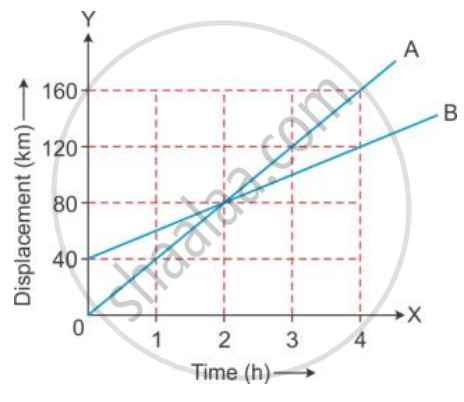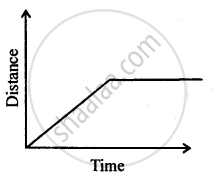Advertisements
Advertisements
प्रश्न
A car covers 90 km in `1 1/2` hours towards east. Calculate
- displacement of car,
- its velocity in (a) kmh−1 (b) ms−1.
उत्तर
(i) A car covers 90 km in `1 1/2` hour i.e. `3/2` hour towards east.
∴ Displacement = 90 km − east
(ii) Time = `1 1/2` hour = `3/2` hour
Velocity = `"Displacement"/"Time"`
v = `90/(3//2)`
v = `(90xx2)/3` = 60 km/h
v = `60xx1000/3600` m/s
v = `100/6` m/s = 16.67 ms−1
APPEARS IN
संबंधित प्रश्न
Is displacement a scalar quantity?
Figure ahead represents the displacement - time sketch of motion of two cars A and B . Find :
(i) the distance by which the car B was initially ahead of car A.
(ii) the velocities of car A and car B.
(iii) the time in which car A catches car B.
(iv) the distance from start when the car A will catch the car B.

A body starts with an initial velocity of 10m s-1 and acceleration 5 m s-2. Find the distance covered by it in 5 s.
Can you suggest the kind of motion of a body from the following distance – time graph?

From the displacement – time graph shown given below calculate:
- Average velocity in the first three seconds.
- Displacement from the initial position at the end of 13 s.
- Time after which the body is at the initial position,
- Average velocity after 8 s.

Can distance covered by a body be less than the magnitude of its displacement?
An object is thrown vertically upwards. It rises upto a height H and then returns to its initial position. Calculate
The total distance traveled by the object
A body moves along a circular path of radius r. When it completes three complete rounds, what is the ratio of distance covered to its displacement?
Distance travelled by a freely falling body is proportional to ______.
If the displacement-time graph of a particle is parallel to the time axis, the velocity of the particle is ______.
